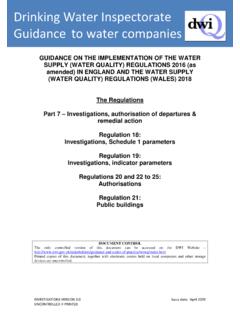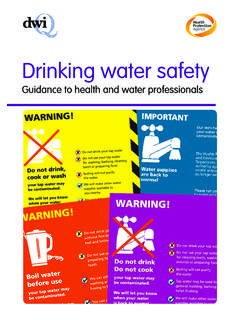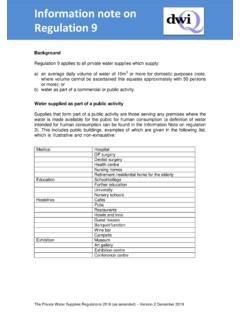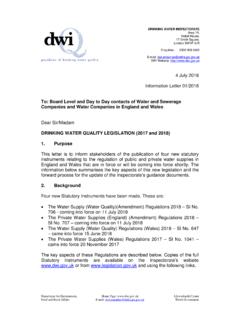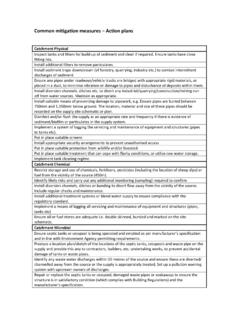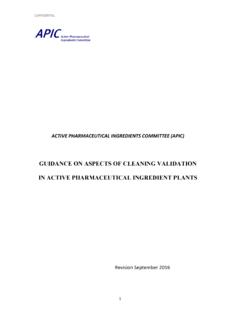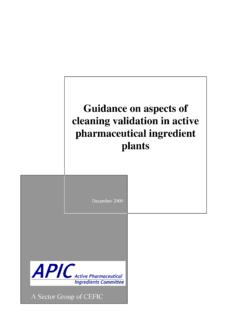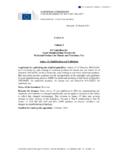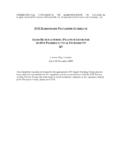Transcription of Guidance on the use of ultraviolet (UV) irradiation …
1 Guidance on the use of ultraviolet (UV) irradiation for the disinfection of public water supplies August 2016 DOCUMENT CONTROL The only controlled version of this document can be accessed on the DWI Website Printed copies of this document, together with electronic copies held on local computers and other storage devices are uncontrolled. DRINKING WATER INSPECTORATE Area 7e, 9 Millbank, c/o Nobel House, 17 Smith Square, London, SW1P 3JR Enquiries: 0300 068 6400 E-mail: Website: Document Owner: DWI Regulations Team Revision No Once printed this is an uncontrolled document Page 2 of 17 Revision History Issue No Date Purpose Author(s) February 2010 Initial Guidance SL, SJ, EC, AQ, JF Revision No Revision date Purpose of revision Revised by August 2016 Review GF, AM, MP DWI Guidance on the use of ultraviolet (UV) irradiation for the disinfection of public water supplies Document Owner: DWI Regulations Team Revision No Once printed this is an uncontrolled document Page 3 of 17 Preface Intended audience: This document is aimed primarily at water suppliers in England and Wales.
2 The devolved administrations in Scotland and Northern Ireland, as with the rest of Europe, have separate but parallel legislation and associated Guidance . Use of the term water supplier in this document refers to a water undertaker, a holder of a combined licence, within the meaning given by section 17A(6) of the Water Industry Act 1991, and a holder of an appointment referred to in section 7(4)(bb) of the Water Industry Act 1991 but, unless the contrary intention appears, does not include the holder of a retail licence (within the meaning given by section 17A(4) of the Water Industry Act 1991). Legal status: This document has been produced to provide Guidance on the use of ultraviolet (UV) irradiation for disinfection of public water supplies in relation to the requirements of the Water Supply (Water Quality) Regulations 20161.
3 The text should not be taken as an authoritative statement or interpretation of the law. Every effort has been made to ensure that these Guidance notes are as accurate and helpful as possible, although it is ultimately the responsibility of individual water suppliers to ensure compliance with the law. Water suppliers with specific queries may wish to seek advice from DWI. Purpose: This document is intended to provide Guidance on the design, operation and monitoring of UV irradiation as a process for the disinfection of public water supplies intended for domestic or food production purposes. The Guidance may also be appropriate to the disinfection of waters analogous to public water supplies, such as unregulated or private water supplies. UV equipment or methods of operation, design and validation will evolve.
4 Water suppliers are therefore not limited by the information provided in this Guidance , and are still obliged to comply with the requirements of the Water Supply (Water Quality) Regulations (as amended) at all times. This Guidance does not consider the principles of disinfection, alternative methods of disinfection or other aspects of disinfection. It is also not intended to apply to sources of water not used for domestic or food production purposes. 1 Water Supply (Water Quality) Regulations 2010 as amended in Wales DWI Guidance on the use of ultraviolet (UV) irradiation for the disinfection of public water supplies Document Owner: DWI Regulations Team Revision No Once printed this is an uncontrolled document Page 4 of 17 Contents 1. Summary 5 2. Introduction 7 3. Disinfection of public water supplies 7 4.
5 Water pre-treatment 8 5. UV disinfection 9 Process validation 9 UV process start-up and restart 11 Process monitoring 12 Process verification 13 6. Disinfection by-products 13 7. Disinfectant residuals 14 8. Lamp and sleeve breakage 14 9. Water fittings and materials in contact with water 15 10. Contact 15 11. Glossary of terms 16 12. Bibliography 17 DWI Guidance on the use of ultraviolet (UV) irradiation for the disinfection of public water supplies Document Owner: DWI Regulations Team Revision No Once printed this is an uncontrolled document Page 5 of 17 Guidance on the use of ultraviolet (UV) irradiation for the Disinfection of Public Water Supplies 1. Summary The disinfection of public water supplies is a statutory requirement in England and Wales. Water supplied for domestic or food production purposes must not contain any micro-organism or parasite at a concentration which could constitute a potential danger to human health.
6 Water suppliers should, therefore: have in place a water treatment policy and a disinfection policy covering all the requirements of regulation 26 of the Water Supply (Water Quality) Regulations; have documentation and procedures in place which ensure that at every works it is unambiguous how regulation 26 is being met, both in principle and in practice; and in accordance with regulation 27, adopt a comprehensive, system-specific risk assessment and risk management ( water safety plan ) approach, that identifies appropriate controls, and incorporates multiple barriers from catchment to consumer. Water suppliers must pre-treat waters to modify their quality in respect of any property known to adversely affect the performance of disinfection processes. In particular the turbidity of waters to be disinfected should be maintained below 1 NTU.
7 In addition the recommendations of the various Expert Groups on Cryptosporidium in water supplies, as summarised in the Badenoch and Bouchier reports, are still relevant and considered as good operational practice. In the case of water to be disinfected using UV treatment chemical residuals which are strong UV absorbers should be kept to a minimum. Chlorine and chloramine used to provide a residual chemical disinfectant concentration into supply should be dosed after UV processes. In accordance with appropriate risk management (a water safety plan approach), each UV reactor must be designed as a control for the identified hazards at each works taking into account the physical and chemical characteristics of the water to be disinfected. The performance of UV reactors must be validated to demonstrate that they meet the intended performance criteria.
8 Independent validation testing is commonly (but not always) undertaken by the manufacturers. Key considerations to take into account are: only UV reactors that have undergone validation testing should be used for disinfection purposes, DWI currently considers full-scale biodosimetry testing to be the most appropriate method of validation until such time as another technique has been proven to be equivalent or better; reactor validation should take into account all operational, water quality, and other factors that may impact on the UV fluence to which pathogens are exposed at each works; reactors must not be operated outside of their range of site-specific validated conditions unless an alternative appropriate risk control measure is in place; and DWI Guidance on the use of ultraviolet (UV) irradiation for the disinfection of public water supplies Document Owner: DWI Regulations Team Revision No Once printed this is an uncontrolled document Page 6 of 17 reactors should be revalidated if changes occur that substantially change their performance.
9 Whether UV irradiation is used alone or in combination with other processes for the disinfection of drinking waters, water suppliers will be required to have evidence-supported justification for the UV fluences used at specific works. The effectiveness of UV disinfection processes must be verified. This will involve the continuous monitoring and recording of the conditions of operation at critical control points. Water suppliers should therefore monitor and record, as a minimum : water flow, lamp status and UV fluence rate within each reactor; UV absorbance where a Calculated Dose approach is employed; turbidities (representative of that within each UV reactor); reactor cleaning, inspection and maintenance; and lamp operating times and dates of lamp replacement The introduction of chemical agents into treated waters to provide a residual disinfectant during distribution should not be used to compensate or as a substitute for inadequate disinfection of the water at a works.
10 Water suppliers are expected to have documented action plans for identifying and responding to lamp or sleeve breakages DWI recommends any water company considering the use of UV irradiation for the disinfection of public water supplies to consult the USEPA ultraviolet Disinfection Guidance Manual (UVDGM) as a useful source of background information. A Bibliography containing this and other relevant information sources, as well as a Glossary of Terms, is appended to the end of this document. DWI Guidance on the use of ultraviolet (UV) irradiation for the disinfection of public water supplies Document Owner: DWI Regulations Team Revision No Once printed this is an uncontrolled document Page 7 of 17 2. Introduction The primary European legislation relating to the quality of water intended for human consumption is the 1998 EU Drinking Water Directive (98/83/EC).


